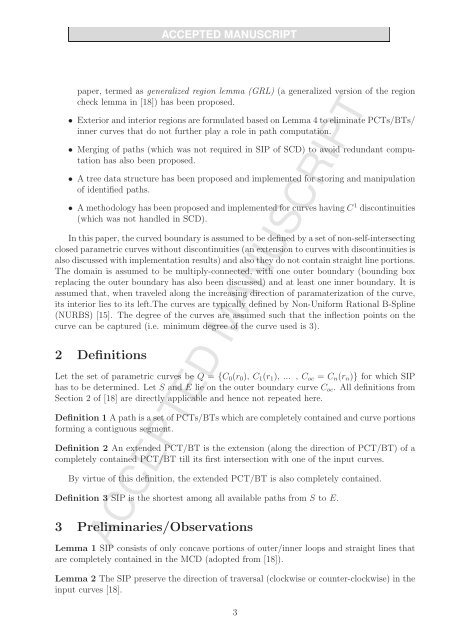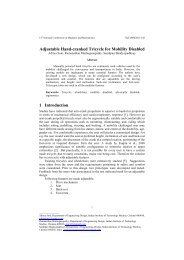Shortest path in a multiply-connected domain having curved ...
Shortest path in a multiply-connected domain having curved ...
Shortest path in a multiply-connected domain having curved ...
You also want an ePaper? Increase the reach of your titles
YUMPU automatically turns print PDFs into web optimized ePapers that Google loves.
paper, termed as generalized region lemma (GRL) (a generalized version of the region<br />
check lemma <strong>in</strong> [18]) has been proposed.<br />
• Exterior and <strong>in</strong>terior regions are formulated based on Lemma 4 to elim<strong>in</strong>ate PCTs/BTs/<br />
<strong>in</strong>ner curves that do not further play a role <strong>in</strong> <strong>path</strong> computation.<br />
• Merg<strong>in</strong>g of <strong>path</strong>s (which was not required <strong>in</strong> SIP of SCD) to avoid redundant computation<br />
has also been proposed.<br />
• A tree data structure has been proposed and implemented for stor<strong>in</strong>g and manipulation<br />
of identified <strong>path</strong>s.<br />
• A methodology has been proposed and implemented for curves hav<strong>in</strong>g C 1 discont<strong>in</strong>uities<br />
(which was not handled <strong>in</strong> SCD).<br />
In this paper, the <strong>curved</strong> boundary is assumed to be def<strong>in</strong>ed by a set of non-self-<strong>in</strong>tersect<strong>in</strong>g<br />
closed parametric curves without discont<strong>in</strong>uities (an extension to curves with discont<strong>in</strong>uities is<br />
also discussed with implementation results) and also they do not conta<strong>in</strong> straight l<strong>in</strong>e portions.<br />
The doma<strong>in</strong> is assumed to be <strong>multiply</strong>-<strong>connected</strong>, with one outer boundary (bound<strong>in</strong>g box<br />
replac<strong>in</strong>g the outer boundary has also been discussed) and at least one <strong>in</strong>ner boundary. It is<br />
assumed that, when traveled along the <strong>in</strong>creas<strong>in</strong>g direction of paramaterization of the curve,<br />
its <strong>in</strong>terior lies to its left.The curves are typically def<strong>in</strong>ed by Non-Uniform Rational B-Spl<strong>in</strong>e<br />
(NURBS) [15]. The degree of the curves are assumed such that the <strong>in</strong>flection po<strong>in</strong>ts on the<br />
curve can be captured (i.e. m<strong>in</strong>imum degree of the curve used is 3).<br />
2 Def<strong>in</strong>itions<br />
Let the set of parametric curves be Q = {C0(r0), C1(r1), ... , Coc = Cn(rn)} for which SIP<br />
has to be determ<strong>in</strong>ed. Let S and E lie on the outer boundary curve Coc. All def<strong>in</strong>itions from<br />
Section 2 of [18] are directly applicable and hence not repeated here.<br />
Def<strong>in</strong>ition 1 A <strong>path</strong> is a set of PCTs/BTs which are completely conta<strong>in</strong>ed and curve portions<br />
form<strong>in</strong>g a contiguous segment.<br />
Def<strong>in</strong>ition 2 An extended PCT/BT is the extension (along the direction of PCT/BT) of a<br />
completely conta<strong>in</strong>ed PCT/BT till its first <strong>in</strong>tersection with one of the <strong>in</strong>put curves.<br />
By virtue of this def<strong>in</strong>ition, the extended PCT/BT is also completely conta<strong>in</strong>ed.<br />
Def<strong>in</strong>ition 3 SIP is the shortest among all available <strong>path</strong>s from S to E.<br />
3 Prelim<strong>in</strong>aries/Observations<br />
Lemma 1 SIP consists of only concave portions of outer/<strong>in</strong>ner loops and straight l<strong>in</strong>es that<br />
are completely conta<strong>in</strong>ed <strong>in</strong> the MCD (adopted from [18]).<br />
Lemma 2 The SIP preserve the direction of traversal (clockwise or counter-clockwise) <strong>in</strong> the<br />
<strong>in</strong>put curves [18].<br />
3




